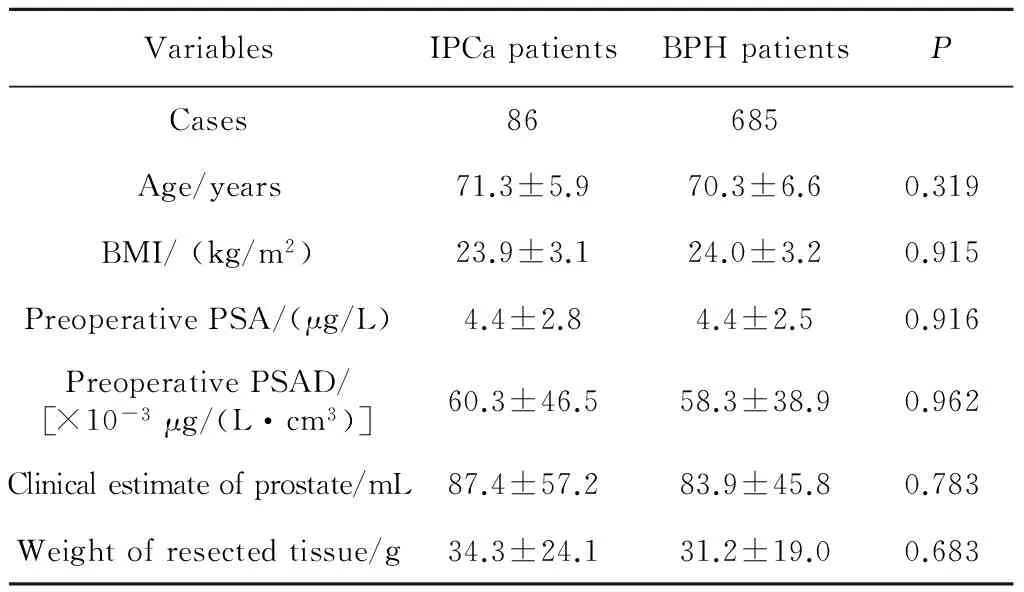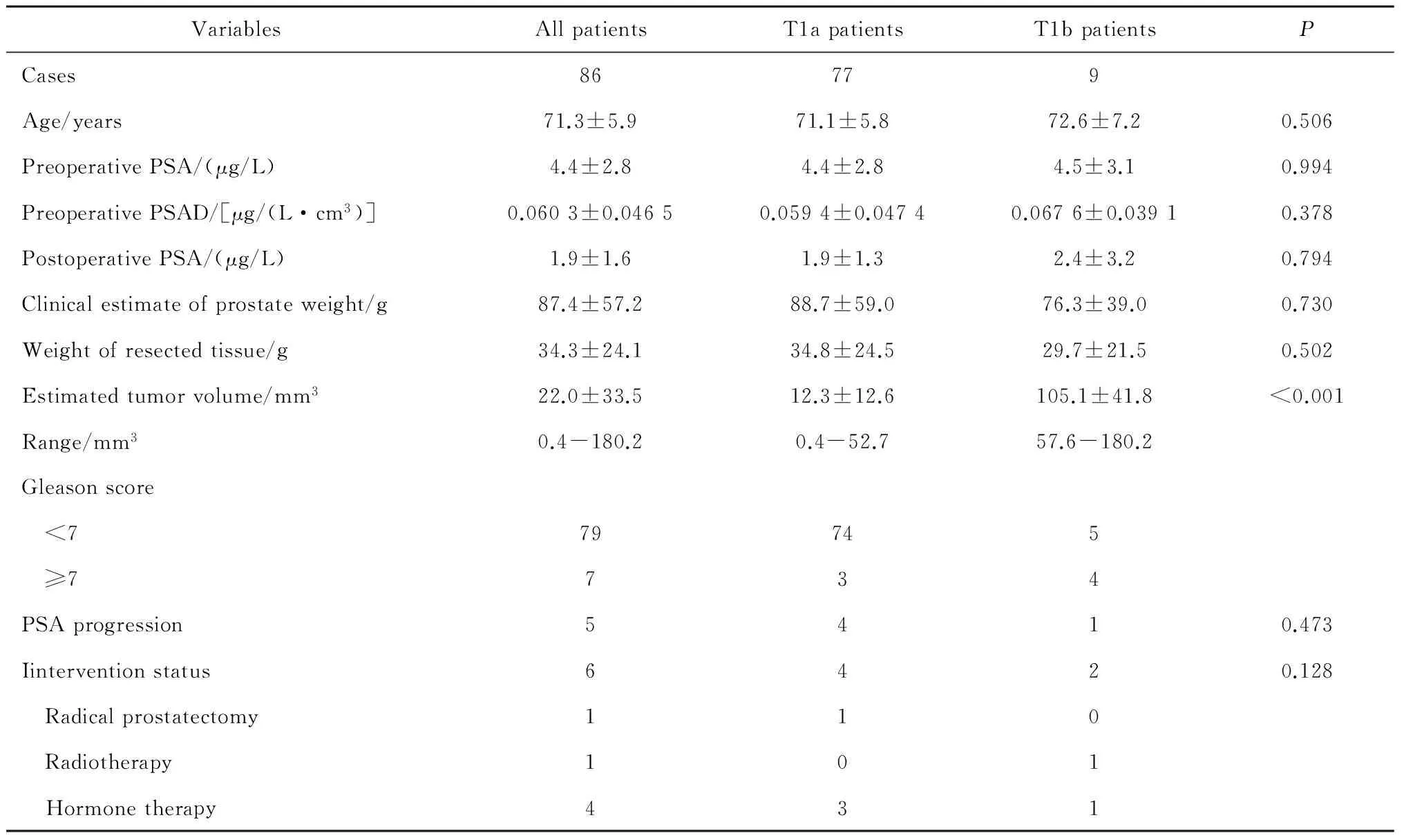T1a~T1b期前列腺癌的诊断与治疗
刘 茁,罗 程,胡 帅,范 宇,刘振华,杨新宇,沈 棋,刘漓波,韩文科,周利群,虞 巍, 何 群,张 骞,金 杰
(北京大学第一医院泌尿外科,北京大学泌尿外科研究所,国家泌尿、男性生殖系肿瘤研究中心,北京 100034)
·论著·
T1a~T1b期前列腺癌的诊断与治疗
刘 茁,罗 程,胡 帅,范 宇,刘振华,杨新宇,沈 棋,刘漓波,韩文科,周利群,虞 巍, 何 群,张 骞,金 杰△
(北京大学第一医院泌尿外科,北京大学泌尿外科研究所,国家泌尿、男性生殖系肿瘤研究中心,北京 100034)
目的:探讨经尿道前列腺电切术后偶发前列腺癌(即T1a~T1b期前列腺癌)的临床病理特点,提高对该病的诊疗认识。方法:回顾性分析2004年5月至2013年9月北京大学第一医院泌尿外科977例因良性前列腺增生(benign prostatic hypertrophy,BPH)而行经尿道前列腺电切手术(transurethral resection of prostate,TURP)患者的临床病理资料,选择其中总前列腺特异抗原(total prostate specific antigen, tPSA)≤10 μg/L,且既往无前列腺或膀胱手术史者共771例,对TURP组织病理标本进行全部取材,由专业病理科医师进行分析,描绘HE染色切片显微镜下的肿瘤轮廓,采用Image J 1.47h软件采集图像,测量肿瘤面积,将每例患者所有切片中的肿瘤面积相加,估算的肿瘤体积等于肿瘤测量面积总和乘以模块厚度。收集患者的临床及病理资料,随访其治疗方式、前列腺特异性抗原(prostate specific antigen, PSA)进展情况、干预治疗的原因及方式、肿瘤特异性病死率等。结果:本组患者发现偶发癌86例,检出率为11.2%,此86例患者肿瘤体积0.4~180.2 mm3,其中T1a期77例(89.5%),平均肿瘤体积为(12.3±12.6) mm3,T1b期9例(10.5%),平均肿瘤体积为(105.1±41.8) mm3。所有患者肿瘤体积均<500 mm3,属于小体积前列腺癌。肿瘤Gleason评分,<7分者79例,≥7分者7例。86例患者初步治疗方案均为等待观察,其中2例失访,中位随访时间88.9个月(27.9~150.1个月)。共5例患者发生PSA进展,其中T1a期4例,T1b期1例,此5例患者均选择干预治疗。T1b期有1例患者虽然未发生PSA进展,但因患者意愿强烈也选择了干预治疗。T1a期患者中,1例选择前列腺根治性切除术,术后未见生化复发;3例选择内分泌治疗,未见治疗后PSA进展。T1b期1例患者选择放疗,未见放疗后生化复发,1例选择内分泌治疗,未见治疗后PSA进展。获得随访的84例患者中非前列腺癌特异性死亡者6例,未见前列腺癌特异性死亡者。结论:本研究偶发癌检出率为11.2%,86例偶发癌均属于小体积前列腺癌,等待观察治疗对T1a~T1b期前列腺癌是一种相对安全的治疗策略。
前列腺肿瘤;前列腺;经尿道前列腺电切术
良性前列腺增生(benign prostatic hypertrophy,BPH)是一种引起中老年男性排尿障碍的常见疾病,对于中、重度下尿路症状或药物治疗效果不佳,部分患者最终需要手术治疗[1],目前,经尿道前列腺电切术(transurethral resection of prostate,TURP)广泛应用于临床,术后行组织病理学检查,除发现前列腺增生外少数患者偶然发现前列腺癌(incidental prostate cancer,IPCa)。大多文献将IPCa等同于临床分期T1a与T1b前列腺癌[2-5]。目前对IPCa的治疗策略选择主要基于传统的观点,即对于T1a期采取延迟治疗,对于T1b期采取积极治疗,然而这一结论是基于一些小样本研究而得出的[6-8],而且目前应用的2002年前列腺癌TNM分期系统起初是根据1992年第4版确定并沿用至今,近20多年未曾更新。本文回顾性分析近10年北京大学第一医院单中心IPCa患者临床病理资料,试图分析其临床病理特点并提高对TURP术后偶发癌的诊疗认识。
1 资料与方法
1.1 一般资料
回顾性分析北京大学第一医院泌尿外科2004年5月至2013年9月977例BPH患者行手术治疗的临床资料。所有患者均无前列腺癌家族史,直肠指诊未触及明显硬结,未行前列腺穿刺。本研究排除15例行2次TURP术患者,2例既往行前列腺激光手术患者,1例既往膀胱肿瘤行经尿道膀胱肿瘤切除术患者,1例行膀胱切开取石术患者,1例行经尿道汽化电切术患者,2例既往慢性肾功能不全患者,剩余956例BPH患者,其中选择tPSA≤10 μg/L者,共771例。临床基本资料包括:年龄、体重指数(body mass index,BMI)、术前总前列腺特异性抗原(total prostate specific antigen, tPSA)、前列腺特异性抗原密度(prostate specific antigen density, PSAD)、前列腺体积、TURP切除组织质量等,其中,BMI=体重(kg)/身高(m)2。PSA测量均在直肠指诊前或指诊1周后。前列腺体积(mL)=π/6×长(cm)×宽(cm)×高(cm)。
1.2 病理资料
首先将手术标本进行称重,对手术标本进行全部取材,并用甲醛溶液固定。将所有标本组织块置入厚度为3 mm的模块中进行石蜡包埋,对每个模块进行切片并进行HE染色。由专业病理科医师进行分析,在光学显微镜下辨认并挑选含有肿瘤的组织块。采用Image J 1.47h软件采集图像,勾画肿瘤轮廓(不含正常前列腺腺体及基质组织), 测量肿瘤面积。将每例患者所有切片中的肿瘤面积相加,估算肿瘤体积=测量肿瘤面积总和×模块厚度[9-10]。
1.3 治疗与随访
对于偶发前列腺癌,所有患者均选择等待观察(watchful waiting, WW)治疗方式。 术后1个月进行首次随访,内容包括PSA检查、询问手术疗效及并发症等,以后每3个月随访1次,2年后每6个月随访1次,5年后每年随访1次。收集随访资料,包括是否发生PSA进展,是否进行干预治疗,干预治疗的原因及方式等。PSA进展指随访过程中PSA值大于等于TURP术后PSA的两倍[11];干预方式包括前列腺根治性切除术、内分泌治疗和放射治疗;根治术后生化复发指连续两次血tPSA≥0.2 μg/L;放疗后生化复发指PSA值高于放疗后最低点2 μg/L;内分泌治疗后PSA进展指连续两次血tPSA≥0.4 μg/L。
1.4 统计学分析
使用SPSS22.0软件进行统计学分析,两组的年龄(岁)、BMI(kg/m2)、术前tPSA(μg/L)、PSAD、前列腺体积(mL)、TURP切除组织质量等数据的比较采用Mann-WhitneyU检验,P<0.05认为差异有统计学意义。
2 结果
本组771例患者平均年龄(71.3±5.9)岁,平均BMI为(23.9±3.1)kg/m2,术前平均tPSA(4.4±2.8)μg/L。发现偶发癌86例,其检出率为11.2%,两组患者临床特征比较见表1。偶发前列腺癌组与良性前列腺增生组,两组年龄、BMI、术前tPSA、PSAD、前列腺体积、TURP切除组织质量等比较,差异均无统计学意义(P>0.05)。
根据肿瘤占前列腺切除组织的百分比对IPCa组86例进行亚组分析(表2),T1a期77例(89.5%), 平均肿瘤体积为(12.3±12.6) mm3;T1b期9例(10.5%), 其平均肿瘤体积为(105.1±41.8) mm3。总86例肿瘤体积为0.4~180.2 mm3。所有患者肿瘤均小于500 mm3,属于小体积前列腺癌。其肿瘤Gleason评分,<7分者79人,≥7分者7人。T1a组与T1b组在年龄、术前tPSA、术前PSAD、术后1月tPSA、前列腺体积、TURP切除组织质量上比较,差异均无统计学意义(P>0.05)。
86例患者均行等待观察治疗,其中2例失访,中位随访时间88.9个月(27.9~150.1个月)。共有5例患者发生PSA进展,其中T1a组4例,T1b组1例,此5例患者均选择了干预治疗。T1a组1人选择前列腺根治性切除术,术后未见生化复发;3例选择内分泌治疗,未见治疗后PSA进展。T1b组1人选择放
疗,未见放疗后生化复发,T1b组中有1例患者虽然没有发生PSA进展,但患者意愿强烈,也选择了干预治疗,1人选择内分泌治疗,未见治疗后PSA进展。所有84例获得随访的患者中,非前列腺癌特异性死亡者6人,无前列腺癌特异性死亡患者。

表1 行经尿道前列腺电切术患者的临床特点Table 1 Clinical characteristics of patients who underwent TURP
IPCa, incidental prostate cancer; BPH, benign prostatic hypertrophy; PSA, prostate specific antigen; BMI, body mass index.

表2 偶发前列腺癌患者临床及病理特征Table 2 Clinical and pathologic findings of patients with incidental prostate cancer
3 讨论
偶发前列腺癌指术前未考虑前列腺癌诊断可能(直肠指诊未触及明显硬结或影像学检查未发现异常),在因下尿路症状(lower urinary tract symptoms,LUTS)等有手术指证而行TURP的标本中,组织学检查偶然发现的前列腺癌[12]。2002年前列腺癌TNM分期中,临床分期T1a期指偶然发现的肿瘤且病变小于前列腺组织的5%,T1b期指偶然发现的肿瘤且病变大于前列腺组织的5%。大多文献将IPCa等同于临床分期T1a与T1b前列腺癌[2-5]。
随着人们对PSA认识的深入,“偶发癌”的概念也在发生不断变化,报道的检出率也有所不同。Jones等[13]认为PSA时代(1994~2000年)偶发癌的检出率较PSA前时代(1986~1987年)显著下降(5.2%和14.9%),尤其以T1b期肿瘤下降为主。PSA时代偶发癌的检出率下降的原因可能为:(1)随着治疗BPH药物的进步,需要TURP等手术解除下尿路症状的患者逐渐减少;(2)对药物治疗效果不满意的患者有一部分选择行经尿道前列腺电汽化术、经尿道射频消融术等,这些手术操作因无法进行病理检查,也导致了IPCa检出率的下降;(3)PSA筛查增大了前列腺穿刺发现前列腺癌的检出率,有一部分原本应被诊断为T1a期或T1b期的患者在出现下尿路症状而行TURP之前,就因为PSA升高而行穿刺发现前列腺癌(归为T1c期)。IPCa的概念中并未对PSA有所限定,本研究将入组人群限定在PSA≤10 μg/L。因为PSA>10 μg/L时,临床医生将高度怀疑患者可能患前列腺癌,因此应行进一步检查,如前列腺穿刺等。而对于穿刺结果阴性的患者,因前列腺穿刺有假阴性率亦不能完全除外其患前列腺癌的可能性,因此认为IPCa的严格定义应该除外PSA指标过高或接受过穿刺活检的患者。
目前对IPCa的治疗策略选择主要基于传统的观点,即对于T1a期采取延迟治疗,对于T1b期采取积极治疗。传统观念认为T1b期偶发癌较T1a期具有较差的临床预后[14-15],然而这一结论是基于一些小样本量研究而得出的[6-8],而且目前应用的2002年前列腺癌TNM分期系统起初是根据1992年第4版确定并沿用至今,近20多年未曾更新。目前很多研究对T分期提出质疑:(1)T分期(T1a和T1b期)不是根治性前列腺切除术(radical prostatectomy,RP)预测残余肿瘤的独立预测因子[16];(2)T分期不能够精确地预测RP术后生化复发[16];(3)TURP术中切除组织总质量可能强烈影响T分期,导致无法单纯反应肿瘤体积或残余肿瘤的特点[16-17]。
前列腺肿瘤体积是能够反映前列腺癌预后的重要指标之一,有学者研究表明[18-21],前列腺肿瘤体积是前列腺根治术后生化复发的独立预测因子。大多数学者认为根治性前列腺切除术后肿瘤体积小于500 mm3的前列腺癌是没有临床意义或临床意义极小的,对于这些患者,更适合进行保守治疗[21-24]。Epstein等[22]最先开始研究“小体积前列腺癌”或“无临床意义前列腺癌”,认为肿瘤体积小于500 mm3患者5年内没有发生疾病进展。van Oort等[23]研究在经过39.5个月随访,无临床意义的前列腺癌(肿瘤体积小于0.5 mL且不含GS4或5分成分)的生化复发率显著偏低,因此建议对于小体积或无临床意义的前列腺癌行期待治疗。本研究86例偶发癌平均估算肿瘤体积0.4~180.2 mm3,均小于500 mm3,因此本课题组认为对86例患者行等待观察治疗是一种相对安全的治疗策略。
近期的研究认为[12,16],发现IPCa后治疗决策的选择应该由以下因素综合决定:(1)残余肿瘤可能性的评估;(2)临床进展可能性的评估;(3)治疗的相对风险;(4)每例患者的预期寿命。并非所有的局限性前列腺癌均需要积极治疗,对于有合并症或预期寿命较短的患者可以采用延迟治疗以提高其生活质量,减少过度治疗导致的危害。等待观察(watchful waiting,WW)是一种以治疗症状为主的保守治疗方式。当患者出现局部进展、全身进展或前列腺癌相关并发症时再采取积极治疗,积极治疗包括采用TURP或者其他手术方式缓解泌尿系梗阻,采用内分泌治疗或者放疗缓解转移病变等。WW治疗没有标准的随访方式,临床医师应根据患者的具体情况制定个体化的随访方式。对IPCa患者行WW具有可行性的原因之一是部分前列腺癌进展非常缓慢。Lee等[11]回顾性分析156位韩国IPCa患者,其中46人选择延迟治疗。患者在延迟治疗随访期间采用PSA检测和直肠指诊(digital rectal examination, DRE)检查。“PSA进展”被定义为TURP术后PSA发生倍增,9例患者因过程中发生疾病进展而进行积极干预治疗,5例患者因强烈意愿而进行干预治疗,所有患者均未发生疾病特异性死亡。Herden 等[25]在一项前瞻性多中心研究中,报道了104例行主动监测(active surveillance,AS)治疗的IPCa患者资料,在平均随访26.5个月后,只有16例患者发生疾病进展,在单因素及多因素分析中,只有PSAD与疾病进展相关,其他指标,如Gleason评分、TNM分期、PSA具体数值及将PSA分为>10 μg/L或<10 μg/L两组,均对是否发生疾病进展无预测价值,发生疾病进展患者的平均术前PSA较未发生进展患者略高(5.12 μg/L与4.08 μg/L),但差异无统计学意义,所有患者均未发生疾病特异性死亡。本中心86例患者均行等待观察治疗,在中位随访时间88.9个月中共5例患者发生PSA进展,随后均选择了干预治疗,随访期间无患者发生前列腺癌特异性死亡,由此我们认为等待观察治疗T1a~T1b期前列腺癌是一种相对安全的治疗策略。
《欧洲泌尿外科指南》[2]认为,如需手术治疗应综合考虑肿瘤临床进展的可能性,治疗的风险及患者生存获益。预期寿命较长且肿瘤分化较差患者可考虑行RP手术。Capitanio等[16]对158例T1a和T1b的偶发癌均行RP治疗,5年无生化复发生存率为92%,随访患者均未出现临床进展或远处转移。虽然手术治疗可以达到较好的根治肿瘤效果,但常伴随手术并发症,例如术中严重出血、直肠损伤、术后阴茎勃起功能障碍、尿失禁等[2]。
本研究为回顾性研究,且随访时间相对较短,需要长期随访和前瞻性研究进一步验证。
综上所述,本组IPCa患者肿瘤体积相对较小,预后良好,因此本课题组认为等待观察治疗T1a~T1b期前列腺癌是一种相对安全的治疗策略。
[1]Oelke M, Bachmann A, Descazeaud A, et al. EAU guidelines on the treatment and follow-up of non-neurogenic male lower urinary tract symptoms including benign prostatic obstruction[J]. Eur Urol, 2013, 64(1): 118-140.
[2]Heidenreich A, Bastian PJ, Bellmunt J, et al. EAU guidelines on prostate cancer. part 1: screening, diagnosis, and local treatment with curative intent-update 2013[J]. Eur Urol, 2014, 65(1):124-137.
[3]Teber D, Cresswell J, Ates M, et al. Laparoscopic radical prostatectomy in clinical T1a and T1b prostate cancer: oncologic and functional outcomes: a matched-pair analysis[J]. Urology, 2009, 73(3): 577-581.
[4]Helfand BT, Mongiu AK, Kan D, et al. Outcomes of radical prostatectomy for patients with clinical stage T1a and T1b disease[J]. BJU Int, 2009, 104(3): 304-309.
[5]Adolfsson J. The management of category T1a-T1b (Incidental) prostate cancer: can we predict who needs treatment[J]. Eur Urol, 2008, 54(1): 16-18.
[6]Cantrell BB, DeKlerk DP, Eggleston JC, et al. Pathological factors that influence prognosis in stage A prostatic cancer: the in-fluence of extent versus grade[J]. J Urol, 1981, 125(4): 516-520.
[7]Jewett HJ. The present status of radical prostatectomy for stages A and B prostatic cancer[J]. Urol Clin North Am, 1975, 2(1):105-124.
[8]Golimbu M, Schinella R, Morales P, et al. Differences in pathological characteristics and prognosis of clinical A2 prostatic cancer from A1 and B disease[J]. J Urol, 1978, 119(5): 618-622.
[9]McNeal JE, Haillot O. Patterns of spread of adenocarcinoma in the prostate as related to cancer volume[J]. Prostate, 2001, 49(1): 48-57.
[10]Iremashvili V, Pelaez L, Manoharan M, et al. Pathologic prostate cancer characteristics in patients eligible for active surveillance: a head-to-head comparison of contemporary protocols[J]. Eur Urol, 2012, 62(3): 462-468.
[11]Lee DH, Chung DY, Lee K, et al. Clinical experiences of incidental prostate cancer after transurethral resection of prostate (TURP) according to initial treatment: a study of a korean high volume center[J]. Yonsei Med J, 2014, 55(1): 78-83.
[12]Capitanio U. Contemporary management of patients with T1a and T1b prostate cancer[J]. Curr Opin Urol, 2011, 21(3): 252-256.
[13]Jones JS, Follis HW, Johnson JR. Probability of finding T1a and T1b (incidental) prostate cancer during TURP has decreased in the PSA era[J]. Prostate Cancer Prostatic Dis, 2008, 12(1): 57-60.
[14]Masue N, Deguchi T, Nakano M, et al. Retrospective study of 101 cases with incidental prostate cancer stages T1a and T1b[J]. Int J Urol, 2005, 12(12): 1045-1049.
[15]Schmid HP, Adolfsson J, Aus G. Active monitoring (deferred treatment or watchful waiting) in the treatment of prostate cancer[J]. Eur Urol, 2001, 40(5): 488-494.
[16]Capitanio U, Scattoni V, Freschi M, et al. Radical prostatectomy for incidental (stage T1a-T1b) prostate cancer: analysis of predictors for residual disease and biochemical recurrence[J]. Eur Urol, 2008, 54(1): 118-125.
[17]Rajab R, Fisher G, Kattan MW, et al. An improved prognostic model for stage T1a and T1b prostate cancer by assessments of cancer extent[J]. Mod Pathol, 2011, 24(1): 58-63.
[18]Palisaar R, Graefen M, Karakiewicz PI, et al. Assessment of cli-nical and pathologic characteristics predisposing to disease recurrence following radical prostatectomy in men with pathologically organ-confined prostate cancer[J]. Eur Urol, 2002, 41(2): 155-161.
[19]Stamey TA, McNeal JE, Yemoto CM, et al. Biological determinants of cancer progression in men with prostate cancer[J]. JAMA, 1999, 281(15): 1395-1400.
[20]Song C, Kang T, Yoo S, et al. Tumor volume, surgical margin, and the risk of biochemical recurrence in men with organ-confined prostate cancer[J]. Urol Oncol, 2013, 31(2): 168-174.
[21]Ramos CG, Roehl KA, Antenor JA, et al. Percent carcinoma in prostatectomy specimen is associated with risk of recurrence after radical prostatectomy in patients with pathologically organ confined prostate cancer[J]. J Urol , 2004, 172(1): 137-140.
[22]Epstein JI, Carmichael M, Partin AW, et al .Is tumor volume an independent predictor of progression following radical prostatectomy? A multivariate analysis of 185 clinical stage B adenocarcinomas of the prostate with 5 years of followup[J]. J Urol, 1993, 149(2): 435.
[23]van Oort IM, Kok DE, Kiemeney LA, et al. A single institution experience with biochemical recurrence after radical prostatectomy for tumors that on pathology are of small volume or “insignificant”[J]. Urol Oncol, 2009, 27(5): 509-513.
[24]Hashimoto Y, Okamoto A, Imai A, et al. Biochemical outcome of small-volume or insignificant prostate cancer treated with radical prostatectomy in Japanese population[J]. Int J Clin Oncol, 2012, 17(2): 119-123.
[25]Herden J, Eminaga O, Wille S, et al. Treatment of incidental prostate cancer by active surveillance: results of the HAROW stu-dy[J]. Urol Int, 2015, 95(2): 229-234.
(2016-04-04收稿)
(本文编辑:王 蕾)
Diagnosis and treatment of T1a-T1b prostate cancer
LIU Zhuo, LUO Cheng, HU Shuai, FAN Yu, LIU Zhen-hua, YANG Xin-yu, SHEN Qi, LIU Li-bo, HAN Wen-ke, ZHOU Li-qun, YU Wei, HE Qun, ZHANG Qian, JIN Jie△
(Department of Urology, Peking University First Hospital, Institute of Urology, Peking University, National Urological and Male Reproductive System Cancer Center, Beijing 100034, China)
Objective:To explore the clinical pathological characteristics and improve the recognition in the diagnosis and treatment of incidental (stage T1a-T1b) prostate cancer. Methods: Seven hundred and seventy-one patients who underwent TURP from May 2004 to September 2013 were analyzed retrospectively. In our institution, TURP specimens should be totally submitted in an extensive sampling method. The tumor area was outlined by estimation of an experienced genitourinary pathologist and calculated by the image analysis system software (Image J 1.47 h). The tumor area was then multiplied by the thickness of tissue. The total sum of all tumor volume was the estimated tumor volume. The clinical and pathological factors, follow-up results were obtained and we aimed to collect information about the period of watchful waiting (WW), PSA progression status, intervention status during the follow-up, the reason for intervention on WW and the type of intervention.Results: The average age of 771 patients was (71.3±5.9) years old, and the average BMI was (23.9±3.1) kg/m2, preoperative average tPSA was (4.4±2.8) μg/L. Eighty-six (11.2%) cases of incidental prostate cancer were detected. The patients in T1a group (77 cases, 89.5%) had tumor volumes of (12.3±12.6) mm3, and the patients in T1b group had tumor volumes of (105.1±41.8) mm3.The range of tumor volume was 0.4-180.2 mm3. The volume of all the 86 cases was less than 500 mm3as the threshold of insignificant cancer. All the patients were managed by WW. The mean follow-up time was 88.9 (27.9-150.1) months.The Gleason score was <7 in 79 patients, and ≥7 in 7 patients. There was no significant difference in age, preoperative tPSA, preoperative PSAD, postoperative tPSA, prostate volume and TURP resection between T1a group and T1b group (P>0.05). Among 84 patients without follow-up losts, PSA progression occurred in 5 patients. One T1a patient underwent radical prostatectomy (RP) as an intervention, and 3 patients underwent hormone therapy. One patient in T1b group underwent radiotherapy for PSA progression and one was treated because of patient preference without evidence of disease progression. There were no patients who died due to prostate cancer. Conclusion: Eighty-six (11.2%) cases of incidental prostate cancer were detected. The tumor volume of all the cases was insignificant cancer.The clinical outcomes of IPCa were satisfactory with the initial treatment of WW in the Chinese population.
Prostate neoplasms; Prostate; Transurethral resection of prostate
时间:2016-9-5 15:56:30
http://www.cnki.net/kcms/detail/11.4691.R.20160905.1556.044.html
R737.2
A
1671-167X(2016)05-0812-05
10.3969/j.issn.1671-167X.2016.05.011
△ Corresponding auther’s e-mail, jinjie@vip.163.com

